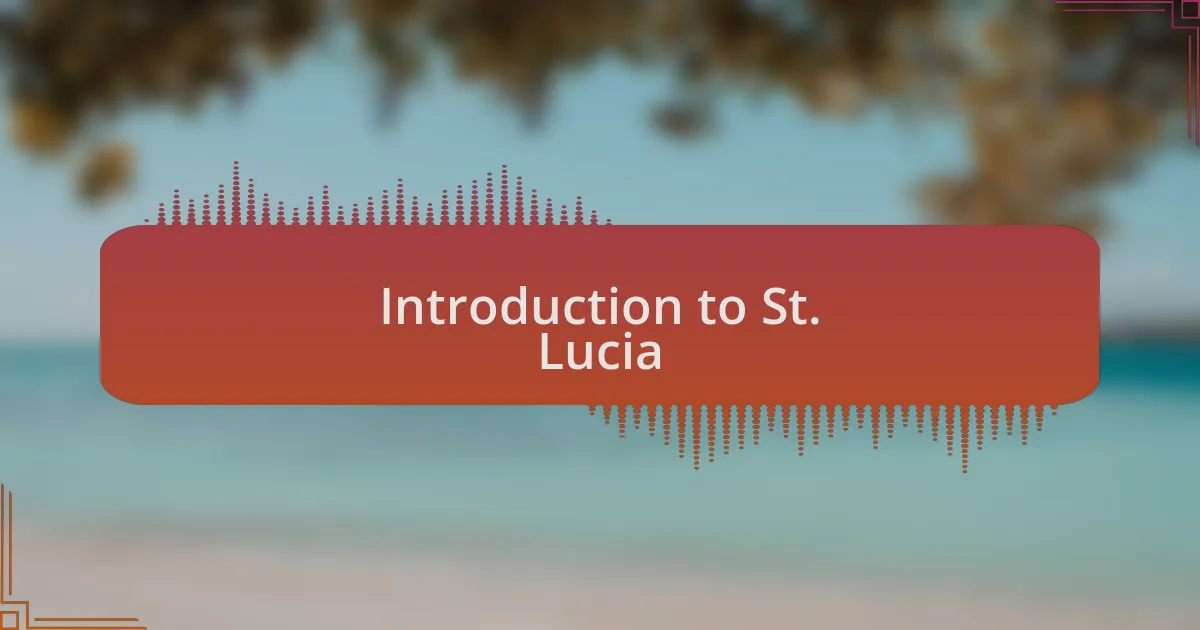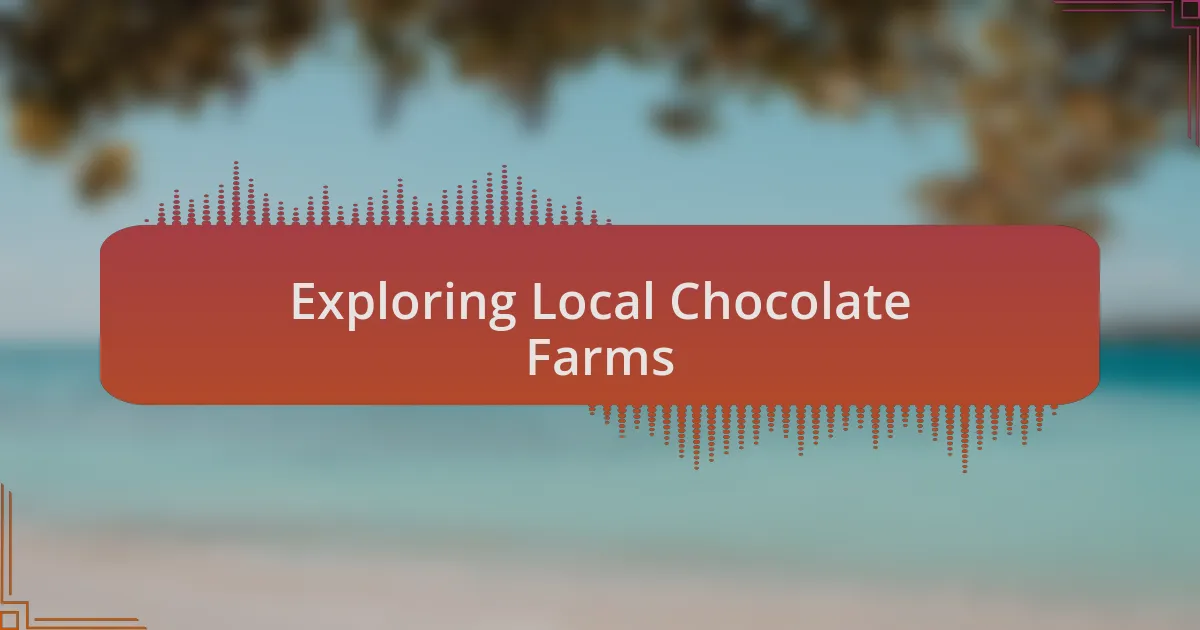Key takeaways:
- Caribbean resorts offer diverse experiences, from luxurious stays to cultural adventures, reflecting the unique essence of each island.
- Local cuisine is integral to cultural identity and sustainability, with resorts often collaborating with local farmers and fishers for fresh ingredients.
- St. Lucia showcases stunning landscapes, rich history, and a warm hospitality that creates a sense of home for visitors.
- Chocolate farms in St. Lucia highlight sustainable agricultural practices and the cultural heritage associated with cocoa cultivation.

Overview of Caribbean Resorts
Caribbean resorts are a treasure trove of diversity, offering everything from luxurious beachfront villas to charming eco-lodges tucked away in lush green landscapes. I remember my first visit to a resort where the gentle sound of waves mingled with the laughter of guests, creating an atmosphere of pure bliss. Isn’t it fascinating how each resort captures the unique essence of its island, making every stay feel special and distinct?
As I explored different resorts throughout the Caribbean, I found that they are not just places to rest; they’re gateways to adventure. Whether it’s snorkeling in crystal-clear waters or dancing to the rhythm of local music, the experiences are as varied as the landscapes. Don’t you want to immerse yourself in that vibrant culture and natural beauty?
Each resort often reflects the local culinary scene, showcasing fresh seafood or traditional dishes that tantalize the taste buds. I vividly remember indulging in a chocolate-infused dessert that took me back to my earlier journey exploring St. Lucian chocolate. The flavors were so rich, making me ponder how food can truly connect us to a place and its people. What unique culinary experiences have you encountered during your travels?

Importance of Local Cuisine
Local cuisine plays a crucial role in defining the cultural identity of a region. During my visit to St. Lucia, I discovered that every dish tells a story, drawing on the island’s history, traditions, and the influences of its diverse population. The first time I tasted bouyon, a traditional stew, it wasn’t just about savoring a meal—it was about experiencing a piece of St. Lucian life that I felt deeply connected to.
When I think about the importance of local cuisine, I cannot overlook the sustainability aspect. Many resorts partner with local farmers and fishers, showcasing not just fresh ingredients but also supporting the community. At one resort, I had the pleasure of joining a farm-to-table dinner, where the chef emphasized that the vegetables we enjoyed were picked just hours earlier. It made me realize how food has the power to foster connections—not only between people but also between them and the land.
Moreover, embracing local cuisine can enhance our travel experiences in profound ways. I often find that sharing a meal with locals opens doors to conversations that reveal insights about their lives and customs. Have you ever sat at a dinner table in a foreign country, surrounded by laughter and stories? It’s moments like these that enrich our journeys and remind us how food unites us all.

Introduction to St. Lucia
St. Lucia is a vibrant Caribbean island known for its stunning natural beauty and rich cultural tapestry. Nestled between the Caribbean Sea and the Atlantic Ocean, it boasts lush rainforests, pristine beaches, and the iconic Pitons—two volcanic spires that capture the heart of every visitor. On my first morning there, the air was filled with the scent of the sea mingling with the earthy aroma of the island’s flora, instantly grounding me in this paradise.
As I strolled through the local markets, I was struck by the warm smiles of the vendors and the lively rhythm of daily life. This familiarity made it easy to lose track of time as I sampled tropical fruits and spices that told their own stories. Have you ever felt so welcomed that it felt like home? That’s exactly how I felt in St. Lucia, where the culture resonates through the hospitality of its people.
The island’s history is deeply intertwined with its music, food, and traditions, reflecting influences from the indigenous Caribs, the French, and the English colonizers. Each flavor in local dishes seemed to hold whispers of those past journeys, connecting me to its heritage in a way that was both profound and enlightening. I remember the first time I participated in a local festival, surrounded by joyous music and dancing—an experience that offered a glimpse into the soul of St. Lucia and its people. Through moments like these, I truly understood that the island is not just a destination; it’s a living, breathing tapestry of experiences waiting to be explored.

Exploring Local Chocolate Farms
Visiting local chocolate farms in St. Lucia is a delightful journey that deepens your appreciation for this beloved treat. I recall stepping onto a cocoa farm for the first time, surrounded by verdant trees laden with pods bursting with potential. As I tasted a fresh cocoa bean straight from the pod, I was surprised by its sweet, fruity flavor—a stark contrast to the rich chocolate we all know. It made me wonder, how many people realize that chocolate begins as a vibrant fruit before becoming the confection we adore?
One of my favorite experiences was interacting with the local farmers, who shared their knowledge of traditional cocoa cultivation methods. Their passion was contagious as they explained how the rich volcanic soil and humid climate create the perfect conditions for growing high-quality cocoa beans. Listening to their stories was not just about chocolate; it felt like connecting with a piece of St. Lucia’s cultural heritage. Have you ever witnessed the kind of dedication that brings a community together? That’s the essence I felt as I walked through the rows of cocoa trees, learning how each harvest is celebrated like a shared triumph.
These farms also engage in sustainable practices that protect the environment while delivering incredible chocolate. Discovering how they incorporate agroforestry into their farming—mixing cocoa trees with pepper and banana plants—made me think about the balance between agriculture and the ecosystem. It really is astonishing to see how the farmers nurture the land as much as they nurture their crops, creating a model for sustainable living that resonates with anyone who cares about where their food comes from. Wouldn’t it be wonderful if more practices like this thrived around the world?